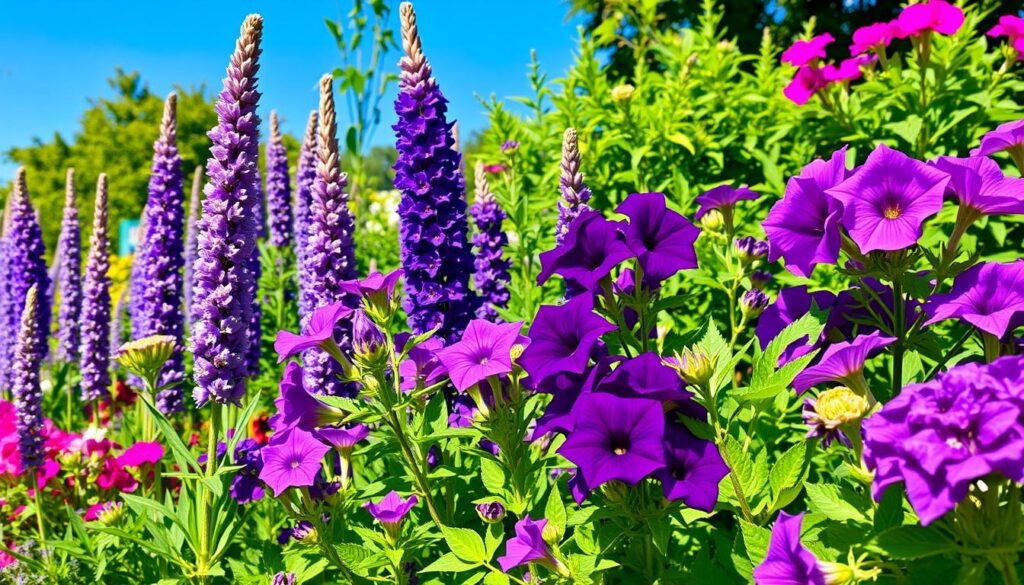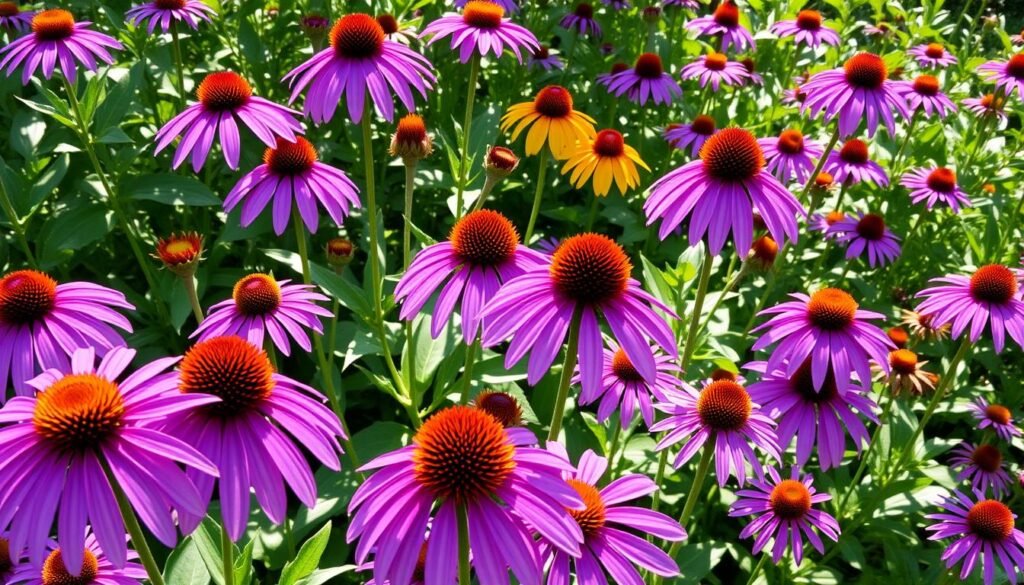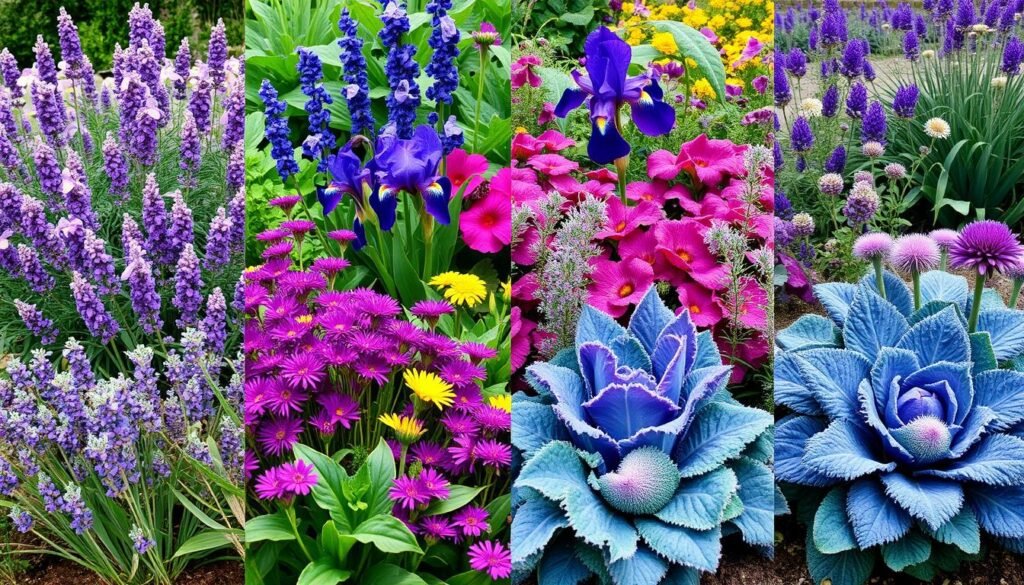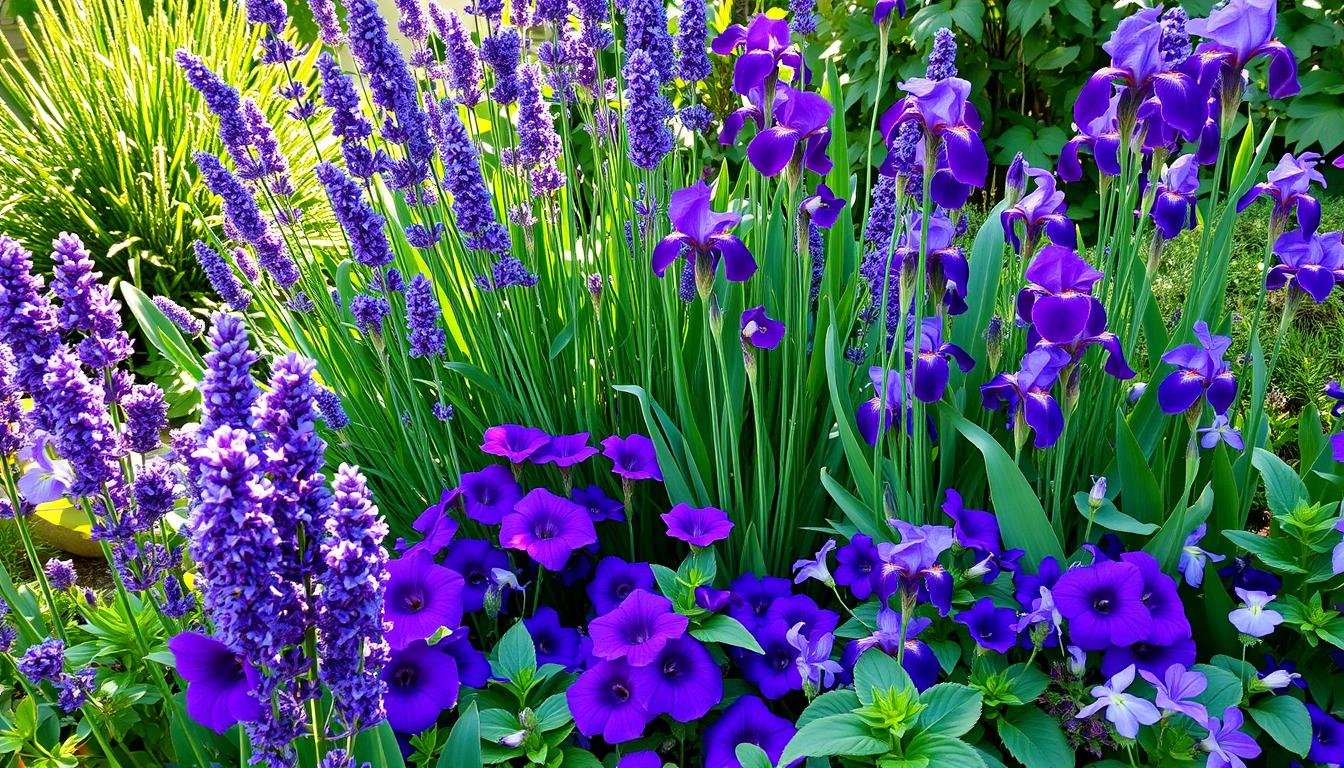Make your garden a vibrant oasis with stunning purple plants. They add beauty and create a magical atmosphere. Plants with royal purple petals draw the eye and attract bees and butterflies.
Choose from fragrant lavender, striking violet blossoms, or deep plum flora. Each choice brings joy and admiration. Let’s explore the unique qualities and benefits of these beautiful purple flowers.
Table of Contents
What Makes Purple Plants Special?
Purple plants add a unique charm to any garden. Their striking colors grab attention. The beauty of purple goes beyond looks, carrying deep meanings in gardening.
From the regal purple petals to the softer lavender shades, these plants stir many emotions. They bring a variety of feelings and meanings.
The Allure of Purple Color in Gardening
Purple color in gardening is more than just pretty. It stands for royalty, elegance, and luxury. This makes purple plants highly sought after.
Their captivating colors can evoke different feelings. Lighter purple can bring calm, while deeper shades excite. Gardeners use color theory to create stunning designs.
They pair purple with colors like blue and silver for harmony. Or they use contrasting colors like orange and yellow for a lively look.
Symbolism and Significance of Purple in Nature
In nature, purple is key for attracting pollinators. Flowers with royal purple petals guide bees and butterflies to their nectar. This helps them reproduce successfully.
Genetic mutation mainly causes purple in foliage. Yet, purple plants remain popular in gardening. They add beauty and diversity to landscapes, thriving with proper care.
Benefits of Incorporating Purple Plants in Your Garden
Adding purple plants to your garden has many benefits. They make your garden look better and help the environment. They attract bees and butterflies, which is good for your garden’s health.
Attracting Pollinators Like Bees and Butterflies
Purple plants are like a signpost for bees and butterflies. They help your garden grow by attracting these important visitors. By choosing plants like lavender, you help your garden thrive. The benefits of purple plants go beyond looks; they help your garden stay healthy.
Creating Visual Interest and Depth
Purple plants add depth and interest to your garden. They come in different shapes and colors, making your garden pop. Pairing dark plants with bright flowers creates a stunning contrast.
This not only catches the eye but also hides unsightly views. It turns your garden into a beautiful show.
Purple plants do more than just look good. They attract good bugs and make your garden more beautiful. By adding them to your garden, you create a space that’s both lovely and useful.
Top Purple Plants to Add to Your Garden
Choosing the right purple plants for your garden is key. Look for ones that are beautiful and useful. Each plant has special qualities that make it a great addition to your garden.
Lavender: The Fragrant Beauty
Lavender is famous for its lovely scent and toughness. It grows 1 to 4 feet tall and does well in zones 5 to 10. Its silvery-green leaves and purple flowers create a calming vibe.
The scent of lavender attracts pollinators. This makes your garden more beautiful and productive.
Purple Coneflower: A Tough Survivor
The purple coneflower is a hardy perennial. It loves sunny spots and can handle drought. Its vibrant blooms add color to your garden from mid-summer to fall.
These flowers not only make your garden look great but also attract pollinators.
Allium: The Purple Fireworks
Allium adds excitement to your garden. Its purple flowers look like fireworks and bloom from late spring to fall. They grow well in zones 3 to 9.
These plants stand out with their unique spherical flower heads. They’re a great choice for any flower bed.
Catmint: A Favorite Among Cats
Catmint has lovely purple flowers and fragrant leaves. It grows about 2 feet tall and thrives in zones 3 to 8. It’s loved by cats and gardeners alike.
This plant is easy to care for. It blooms from June to September, adding color and fragrance to your garden all summer.

| Plant | Height | Bloom Season | Zones |
|---|---|---|---|
| Lavender | 1-4 ft | July-August | 5-10 |
| Purple Coneflower | 2-4 ft | Mid-summer to Fall | 3-9 |
| Allium | 1-3 ft | Late Spring to Fall | 3-9 |
| Catmint | 2 ft | June-September | 3-8 |
Unique Characteristics of Lavandula angustifolia
Lavandula angustifolia, also known as English lavender, is a favorite in many gardens. It’s loved for its beauty and sweet scent. This perennial plant does best in certain conditions, making it great for different garden designs. It grows well in USDA zones 5B to 8, coming from Europe.
Growing Conditions
Lavandula angustifolia loves full sun and dry, well-drained soil. It does well in poor soil, making it perfect for tough spots. It grows 2 to 3 feet tall and 2 to 4 feet wide. From June to August, it blooms with beautiful purple flowers that draw butterflies and bees.
This lavender is also good with drought, pollution, and shallow soils. It’s a hardy plant that can handle a lot.
Using Lavender in Landscapes
Lavandula angustifolia is great for many uses in gardens. It’s a beautiful ground cover, works well in big groups, or stands out in borders. Its small size is perfect for pots too.
Pair it with other drought-resistant plants like purple coneflower or yarrow. This creates a fragrant and beautiful garden that everyone will love.

| Characteristic | Details |
|---|---|
| Native Range | Europe |
| Zone | 5 to 8 |
| Height | 2.00 to 3.00 feet |
| Spread | 2.00 to 4.00 feet |
| Bloom Time | June to August |
| Sun Requirements | Full sun |
| Attracts | Butterflies |
| Tolerates | Rabbit, Deer, Drought, Dry Soil, Shallow-Rocky Soil, Air Pollution |
| Genus Name Meaning | From Latin ‘lavo’ meaning ‘I wash’ |
| Specific Epithet Meaning | Having narrow leaves |
Understanding Purple Coneflower Varieties
The purple coneflower, also known as Echinacea, is loved by gardeners for its beautiful blooms and toughness. There are many purple coneflower varieties, each with its own special qualities. These flowers add color and help the environment in your garden.
Types of Purple Coneflowers
There are many purple coneflower varieties in the Echinacea family. Each variety has its own look, making it easy to find the right one for your garden. Some popular ones include:
- ‘Magnus’ – Known for its large, vibrant purple petals.
- ‘Cheyenne Spirit’ – Offers a rainbow of colors ranging from yellow to red.
- ‘PowWow Wild Berry’ – A robust hybrid with bright pink flowers.
- ‘Green Envy’ – Unique for its initial green hue that transitions to magenta.
These flowers are not just pretty. They also attract important pollinators, helping to make your garden more diverse.
Care Requirements and Benefits
Caring for purple coneflowers is easy. They love sunny spots and can grow in many types of soil. Just make sure to water them right, letting the soil dry out a bit between waterings.
Adding Echinacea to your garden has many benefits. They bloom for a long time, from summer to fall. This brings color to your garden and attracts bees and butterflies. It makes your garden a welcoming place for these important creatures.
Learn more about the different purple coneflower varieties and how to grow them here.

By choosing the right variety and taking good care of them, you can make your garden more beautiful and healthy.
Purple Plants for Every Season
Purple plants make any garden beautiful all year round. They add vibrant colors and interest in every season. Whether you want spring blooms or stunning summer flowers, there are many options. Here are some plants that do well in spring and summer, making your garden look amazing.
Spring Blooms: Crocuses and Clematis
When the cold starts to fade, spring blooms like crocuses pop up. These small flowers have beautiful purple petals that welcome warmer weather. Clematis, a climbing vine, has gorgeous purple flowers and adds height by growing up fences or trellises. Together, these seasonal purple plants bring life and color back to your garden.
Summer Stars: Vivid Petunias and Hyacinths
In summer, your garden can be a colorful display with summer flowers like petunias and hyacinths. Petunias spread out, showing off their bright colors and attracting butterflies. Hyacinths keep giving off sweet scents all summer, keeping your garden beautiful. Check out the featured article for more purple perennials to add to your garden.

| Plant Name | Season | Color | Height (ft) |
|---|---|---|---|
| Crocus | Spring | Purple | 0.5 – 1 |
| Clematis | Spring | Purple | 6 – 10 |
| Petunia | Summer | Vivid Purple | 1 – 3 |
| Hyacinth | Summer | Purple | 1 – 2 |
Tips for Designing with Purple Plants
Using purple plants in your garden can make it look amazing. It’s all about picking the right colors and arranging them in a way that catches the eye. This makes your garden stand out.
Color Pairings with Purple
Pair purple with bright colors like yellow or orange for a bold look. These colors grab your attention and add *garden depth*. On the other hand, soft colors like white or blue can make your garden feel calm and peaceful.
For a fancy look, mix different purple shades with green. This creates a balanced and interesting design. Spend some time researching plants in various purples to find the perfect mix for your garden.
Creating Depth and Texture
Adding depth and texture to your garden is key when using purple plants. Use plants of different heights and shapes to make your garden interesting. Tall plants can be the background, while shorter ones fill in the front.
Adding purple-leaved shrubs or climbing vines like sweet potato vine ‘Blackie’ adds vertical interest. Planting purple plants together creates a beautiful purple area. Make sure to think about when each plant blooms to keep your garden colorful all year.
Maintaining Your Purple Plants
Keeping your purple plants healthy is key. They love well-drained soil and full sun. Make sure to water them right, as too much water can harm them.
Watering and Light Requirements
Give your purple plants lots of sunlight. Most do best in full sun. But, some like Tradescantia pallida can handle shade too.
Choose a spot with rich, moist soil. This helps them stay healthy and prevents leaf problems.
Common Pests and Diseases
Watch out for pests and diseases too. Purple plants may get aphids, mealybugs, and scale insects. Check them often and use organic pest control.
Also, be careful of root rot from bad drainage. Keep the soil healthy and water right to enjoy purple blooms. For more tips, check out this guide.



